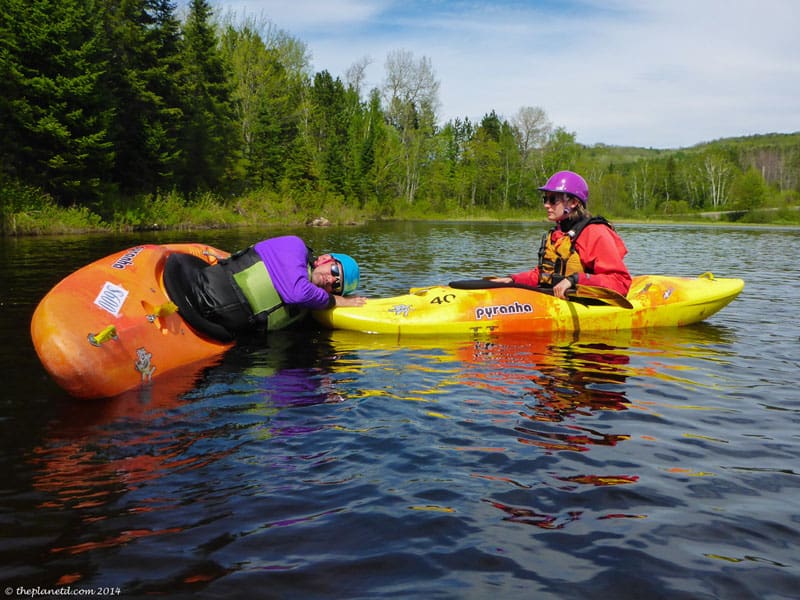Summary of Our Whitewater Kayaking Experience
Our Adventure into Whitewater Kayaking
I awoke in the morning with that sense of panic one gets when facing the unknown. Dave and I are in Barry’s Bay, Ontario, starting a five-day intensive whitewater kayaking course with Madawaska Kanu Centre.

We’ve had our share of kayaking adventures around the globe, primarily focusing on sea kayaking. However, we never needed to demonstrate wet exits or execute proper paddle strokes for steering. This is about to change.
Learning to Whitewater Kayak
On our first day, the focus was on flipping our kayaks repeatedly and mastering the essential skills for maneuvering on flat water with effective paddle strokes. It’s hard to fathom that by day five, we will navigate class 2 and 3 rapids.
The Madawaska Kanu Centre is a pioneer in whitewater kayaking education in Canada. Founded by Hermann and Christa Kerckhoff in 1972, it has established itself as the leading kayaking school in the nation. Claudia, their daughter, held the Canadian women’s kayaking championship title for ten years and now advises on events like the Olympics.
For anyone looking to learn whitewater paddling, this is the premier location. Claudia and her husband Dirk Van Wijk now manage MKC and Owl Rafting alongside their daughters, Stefani and Katrina. During our visit, Stefani was running MKC while Katrina competed in a kayaking championship out west. She holds three Slalom Kayak Champion titles!
Our group comprises nine enthusiastic beginners, ranging from university students to energetic seniors. Kayaking is truly a sport for everyone, and I loved it when Cal, one of our elder members, mentioned, “I’ve seen kids driving around with those sporty little kayaks, and I wanted to be a part of that club.” Soon, he will be.
Time to Get Started…
Our instructors, Juroj and Fidel, guided us throughout the week, starting with the fundamental paddling techniques. Our first task was to paddle in a straight line. While this may sound straightforward, we quickly found that every paddle stroke turned our boats, making it feel like we were a bunch of rubber duckies bobbing in circles.
After a few demonstrations, we began to improve. We practiced our strokes, learning to keep our paddles vertical and close to the boat. We mastered the sweep stroke, backstroke, and reverse stroke, enabling us to maintain control and direction.
Before long, we were able to maneuver in semi-straight lines. Dave and I practiced by paddling towards each other, passing, then executing a sweep stroke to perform a 180-degree turn. It felt like an exhilarating game of chicken on the kayaks while enhancing our control.
Once we became accustomed to our above-water strokes, it was time for the essential underwater control. We knew it was inevitable, so we purposefully capsized our kayaks to practice wet exits.
Time for the Wet Exit. Brrrr…
The Madawaska Kanu Centre introduces the wet exit technique in a tranquil manner. Our initial flip didn’t even require us to secure our spray skirts. All we needed to do was flip our boats and swim out. Eager to confront my fears, I volunteered first.
I had no issue flipping over, but the icy water stole my breath, and I gasped as I resurfaced. My usual response to cold water is dislike. When Dave asked how it went, I promptly replied, “I don’t like it!”
I felt freezing and frightened, wondering if I could continue. Watching others flipping and appearing comfortable made me question, “Why do I always panic in cold water?” As I fought to regain my composure, I stayed in the water, working on my breathing. Eventually, I felt ready to conquer my fear.
Fear Subsides
With focused breathing, I relaxed my mind and flipped again. Underwater, I concentrated on calmness; as Fidel helped me right myself, I found I was surprisingly warm. After a few more flips and rolls, I surprisingly felt relaxed.
This entire experience happened before lunch!
As the sun shone and the water felt comfortable, we were ready to take on the day. The rest of the afternoon included practicing braces, where we leaned dangerously close to tipping our kayaks yet managed to stabilize by smacking our paddles on the water. The control we gained was astonishing.
The Bow Rescue
As the day began to wind down, we learned the bow rescue technique. Previously, if we capsized, we executed a wet exit. With the bow rescue, we would flip and signal for a partner to assist, helping us to right our boats using their kayak for balance.
At the day’s conclusion, Dave performed the bow rescue flawlessly. I believed I would excel, considering my hip control rated highly by the instructors. However, as fate would have it, overcoming old fears isn’t instantaneous. When I flipped and awaited rescue, panic surged through me.
The Fear is Back…
I panicked and clawed my way out of the kayak instead of calmly righting myself. I realized that ending the day in distress would not bode well for tomorrow. Thus, I made one final attempt as my peers removed their kayaks from the water. I didn’t succeed, but I didn’t panic either. I concluded the day with a renewed determination to improve.
Day one of whitewater kayaking was incredibly engaging. We acquired numerous skills in one day, and ample learning awaited us over the following days. As we drifted off to sleep that night, Dave and I were confident that by Friday, we would achieve our goal: navigating rapids while enjoying the thrill of whitewater kayaking.
For whitewater kayak, canoe, and rafting experiences, visit http://owl-mkc.ca/mkc/.





